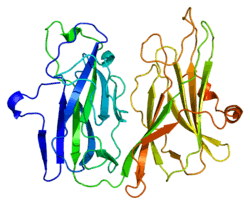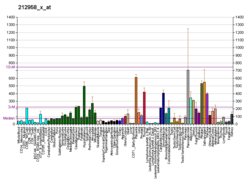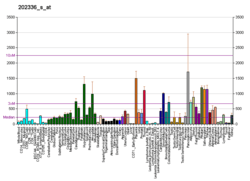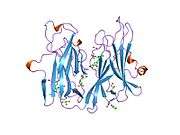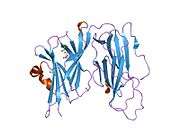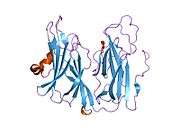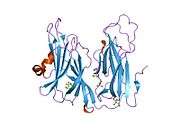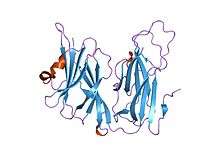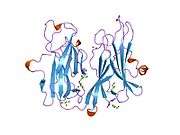Peptidylglycine alpha-amidating monooxygenase
Peptidyl-glycine alpha-amidating monooxygenase is an enzyme that is required for the biosynthesis of many signaling peptides. This transformation is achieved by conversion of a prohormone to the corresponding amide (C(O)NH2). This enzyme is the only known pathway for generating peptide amides, which renders the peptide more hydrophilic.[5] In humans, PAM is encoded by the PAM gene.[6][7]
Function
This gene encodes a multifunctional protein. It has two enzymatically active domains with catalytic activities - peptidylglycine alpha-hydroxylating monooxygenase (PHM) and peptidyl-alpha-hydroxyglycine alpha-amidating lyase (PAL). These catalytic domains work sequentially to catalyze neuroendocrine peptides to active alpha-amidated products. Multiple alternatively spliced transcript variants encoding different isoforms have been described for this gene, but some of their full-length sequences are not yet known.[7]
The PHM subunit effects hydroxylation of an O-terminal glycine residue:
- peptide-C(O)NHCH2CO2− + O2 + 2 [H] → peptide-C(O)NHCH(OH)CO2− + H2O
Involving hydroxylation of a hydrocarbon by O2, this process relies on a copper cofactor. Dopamine beta-hydroxylase, also a copper-containing enzyme, effects a similar transformation.
The PAL subunit then completes the conversion, by catalyzing elimination from the hydroxylated glycine:
- peptide-C(O)NHCH(OH)CO2− → peptide-C(O)NH2 + CH(O)CO2−
The eliminated coproduct is glyoxylate, written above as CH(O)CO2−.
References
- 1 2 3 GRCh38: Ensembl release 89: ENSG00000145730 - Ensembl, May 2017
- 1 2 3 GRCm38: Ensembl release 89: ENSMUSG00000026335 - Ensembl, May 2017
- ↑ "Human PubMed Reference:".
- ↑ "Mouse PubMed Reference:".
- ↑ Eipper BA, Milgram SL, Husten EJ, Yun HY, Mains RE (1993). "Peptidylglycine alpha-amidating monooxygenase: a multifunctional protein with catalytic, processing, and routing domains.". Protein Sci. 2 (4): 489–97. PMC 2142366
 . PMID 8518727. doi:10.1002/pro.5560020401.
. PMID 8518727. doi:10.1002/pro.5560020401. - ↑ Glauder J, Ragg H, Rauch J, Engels JW (Jul 1990). "Human peptidylglycine alpha-amidating monooxygenase: cDNA, cloning and functional expression of a truncated form in COS cells". Biochem Biophys Res Commun. 169 (2): 551–8. PMID 2357221. doi:10.1016/0006-291X(90)90366-U.
- 1 2 "Entrez Gene: PAM peptidylglycine alpha-amidating monooxygenase".
Further reading
- Pittner RA, Albrandt K, Beaumont K, Gaeta LS, Koda JE, Moore CX, Rittenhouse J, Rink TJ (1994). "Molecular physiology of amylin.". J. Cell. Biochem. 55 Suppl (S1994A): 19–28. PMID 7929615. doi:10.1002/jcb.240550004.
- Ouafik LH, Stoffers DA, Campbell TA, Johnson RC, Bloomquist BT, Mains RE, Eipper BA (1992). "The multifunctional peptidylglycine alpha-amidating monooxygenase gene: exon/intron organization of catalytic, processing, and routing domains.". Mol. Endocrinol. 6 (10): 1571–84. PMID 1448112. doi:10.1210/me.6.10.1571.
- Maltese JY, Eipper BA (1993). "Developmental expression of peptidylglycine alpha-amidating monooxygenase (PAM) in primary cultures of neonatal rat cardiocytes: a model for studying regulation of PAM expression in the rat heart.". Mol. Endocrinol. 6 (12): 1998–2008. PMID 1491686. doi:10.1210/me.6.12.1998.
- Braas KM, Harakall SA, Ouafik L, Eipper BA, May V (1992). "Expression of peptidylglycine alpha-amidating monooxygenase: an in situ hybridization and immunocytochemical study.". Endocrinology. 130 (5): 2778–88. PMID 1572293. doi:10.1210/en.130.5.2778.
- Roberts AN, Leighton B, Todd JA, Cockburn D, Schofield PN, Sutton R, Holt S, Boyd Y, Day AJ, Foot EA (1990). "Molecular and functional characterization of amylin, a peptide associated with type 2 diabetes mellitus.". Proc. Natl. Acad. Sci. U.S.A. 86 (24): 9662–6. PMC 298561
 . PMID 2690069. doi:10.1073/pnas.86.24.9662.
. PMID 2690069. doi:10.1073/pnas.86.24.9662. - Vos MD, Jones JE, Treston AM (1995). "Human peptidylglycine alpha-amidating monooxygenase transcripts derived by alternative mRNA splicing of an unreported exon.". Gene. 163 (2): 307–11. PMID 7590286. doi:10.1016/0378-1119(95)00364-C.
- Tsukamoto T, Noguchi M, Kayama H, Watanabe T, Asoh T, Yamamoto T (1995). "Increased peptidylglycine alpha-amidating monooxygenase activity in cerebrospinal fluid of patients with multiple sclerosis.". Intern. Med. 34 (4): 229–32. PMID 7606087. doi:10.2169/internalmedicine.34.229.
- Yun HY, Johnson RC, Mains RE, Eipper BA (1993). "Topological switching of the COOH-terminal domain of peptidylglycine alpha-amidating monooxygenase by alternative RNA splicing.". Arch. Biochem. Biophys. 301 (1): 77–84. PMID 7680192. doi:10.1006/abbi.1993.1117.
- Mains RE, Milgram SL, Keutmann HT, Eipper BA (1995). "The NH2-terminal proregion of peptidylglycine alpha-amidating monooxygenase facilitates the secretion of soluble proteins.". Mol. Endocrinol. 9 (1): 3–13. PMID 7760848. doi:10.1210/me.9.1.3.
- Tateishi K, Arakawa F, Misumi Y, Treston AM, Vos M, Matsuoka Y (1995). "Isolation and functional expression of human pancreatic peptidylglycine alpha-amidating monooxygenase.". Biochem. Biophys. Res. Commun. 205 (1): 282–90. PMID 7999037. doi:10.1006/bbrc.1994.2662.
- Martínez A, Montuenga LM, Springall DR, Treston A, Cuttitta F, Polak JM (1993). "Immunocytochemical localization of peptidylglycine alpha-amidating monooxygenase enzymes (PAM) in human endocrine pancreas.". J. Histochem. Cytochem. 41 (3): 375–80. PMID 8094086. doi:10.1177/41.3.8094086.
- Kapuscinski M, Green M, Sinha SN, Shepherd JJ, Shulkes A (1993). "Peptide alpha-amidation activity in human plasma: relationship to gastrin processing.". Clin. Endocrinol. (Oxf). 39 (1): 51–8. PMID 8102327. doi:10.1111/j.1365-2265.1993.tb01750.x.
- Yun HY, Keutmann HT, Eipper BA (1994). "Alternative splicing governs sulfation of tyrosine or oligosaccharide on peptidylglycine alpha-amidating monooxygenase.". J. Biol. Chem. 269 (14): 10946–55. PMID 8144680.
- Ouafik LH, Mattei MG, Giraud P, Oliver C, Eipper BA, Mains RE (1994). "Localization of the gene encoding peptidylglycine alpha-amidating monooxygenase (PAM) to human chromosome 5q14-5q21.". Genomics. 18 (2): 319–21. PMID 8288234. doi:10.1006/geno.1993.1471.
- Husten EJ, Tausk FA, Keutmann HT, Eipper BA (1993). "Use of endoproteases to identify catalytic domains, linker regions, and functional interactions in soluble peptidylglycine alpha-amidating monooxygenase.". J. Biol. Chem. 268 (13): 9709–17. PMID 8486658.
- Yun HY, Milgram SL, Keutmann HT, Eipper BA (1996). "Phosphorylation of the cytosolic domain of peptidylglycine alpha-amidating monooxygenase.". J. Biol. Chem. 270 (50): 30075–83. PMID 8530412. doi:10.1074/jbc.270.50.30075.
- Morris KM, Cao F, Onagi H, Altamore TM, Gamble AB, Easton CJ (1 December 2012). "Prohormone-substrate peptide sequence recognition by peptidylglycine α-amidating monooxygenase and its reflection in increased glycolate inhibitor potency". Bioorganic & Medicinal Chemistry Letters. 22 (23): 7015–7018. PMID 23084901. doi:10.1016/j.bmcl.2012.10.004.
